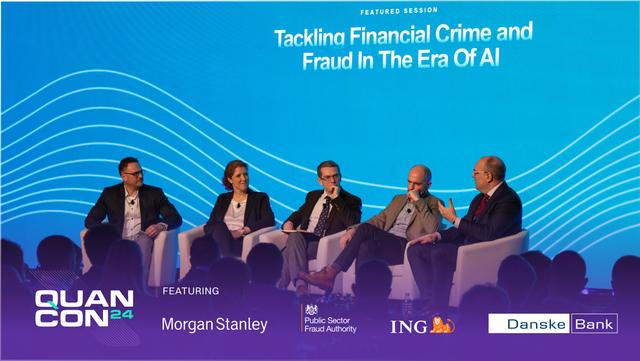How To Identify The 4 Key Enablers Of Financial Crimes Hiding In Your Bank
Take a proactive approach to uncovering and detecting prevalent financial crimes using typology-based scorecards.
With trillions of dollars in laundered funds flooding through the worldwide banking system annually, financial institutions are searching for new solutions, like Contextual Monitoring, to identify criminal networks and shut down the flow of illicit funds.
These revenues flow from a variety of nefarious activities including terrorism, human trafficking, wildlife trafficking, and organized crime. Traditional transaction monitoring approaches are only capable of detecting part of the puzzle by flagging potentially risky transactions–many of which result in false positives and rely too heavily on a human analyst to uncover the broader organized criminal network.
![]()
But what if you could turn this model on its head by using "scorecards" to assess risks in a new way?
In this article, we'll discuss how Quantexa has built dedicated methods to detect shell corporations, phoenixing, controlling minds, and money mules into its revolutionary Decision Intelligence Platform. These typology-based scorecards allow automated alert generation, grouping, and scoring that deliver more effective triaging and greater investigative clarity.
4 key enablers of financial crime
While criminal methods and typologies do change, and new themes can emerge (the recent growth of online scams through phishing is a good example), the core 'building blocks' that point to organized crime often remain consistent.
If you can successfully identify these signifiers as they unfold, your chances of detecting suspicious activities proactively will rise exponentially. Here's how these four key enablers of financial crimes break down.
1. Shell, shelf, and front corporations
These front companies often exist only on paper. Criminals like them because the true identity of the owner can remain hidden.
Multiple shell companies can be set up across different jurisdictions—counties, states, or countries to make tracing money transfers more difficult to follow. Bogus invoices for non-existent goods or services can be passed through these entities to justify the transactions and allow the funds to be moved from one shell company to another, making dirty money appear clean.
Sometimes shell companies are used to "loan" money to each other, which makes tracing funds even more difficult. When set up in separate countries, money launderers can leverage a lack of transparency between different regulatory environments to make identifying illicit fund transfers nearly impossible to follow.
2. Phoenixing
This is the practice of starting a new company upon the dissolution of a previous enterprise. For example, a bank might detect a high-risk individual or business in their book. They cease doing business with that customer because they have identified them as being high-risk.
The next day, however, another similarly named entity with the same director at the same street address or the same shared phone number puts in a new onboarding request and a new business literally "rises" out of the ashes of the old.
3. Controlling mind
In legal circles, this term refers to the single individual who has the “controlling mind” of the company. In normal business practice, this individual would be responsible for taking on the liabilities of the company.
Similarly, the controlling mind in money laundering schemes is the kingpin of the operation. This could be the head of a drug cartel or someone high up in a crime syndicate. If you think of this entity as the hub of a wheel, there might be 50 businesses radiating outward from one individual or 100 businesses associated with a single address.
Interestingly, this controlling mind often sits in plain sight within the bank's retail book, seemingly disconnected from high-risk transaction flows. As such, in traditional transaction monitoring, they would never be alerted and then investigated.
4. Money mules
In this scenario, a person (the money mule) receives money from a third party in their bank account. They might then transfer it to another account or withdraw the funds in cash to physically pay someone else. They then get a fee for their services.
Money mules can also reveal themselves in bank account takeovers in which an account held by one individual is used by others to transfer funds from one party to another. Think of it this way: If I'm a criminal with untold resources, I might approach a student and offer them $50,000 to "use their account." It doesn't take a lot of monetary incentive to set up these kinds of relationships.
Detecting financial crimes in action
Here are some recent examples of how the key enablers of financial crime involving money laundering were thwarted by the authorities:
A recent $3 billion money-laundering probe in Singapore led to the arrest of 10 individuals and had the ear markings of all of these building blocks—falsified documents, shell companies, phoenix operations, and controlling minds that illegal gambling proceeds from China flowed through, and more.
In a huge human trafficking case brought by the Department of Justice, "the defendants conspired to engage in financial transactions designed to conceal the nature, location, source, ownership, and control of ill-gotten proceeds of illicit human smuggling and the unlawful harboring and transportation of undocumented aliens." Assets seized totaled more than 6 million dollars.
Europol reports that 33 people were arrested as part of an "intricate system used to launder drug money for criminal networks." They seized EUR 18.5 million in assets.
The funding of terrorist organizations through money laundering continues to be high on the watchlist as The Department of Justice showed in a recent case in which charges of sanctions evasion and money laundering were brought against global terrorist Mohammad Bazzi. In this case, Bazzi was accused of trying to move hundreds of thousands of dollars from the United States to Lebanon without being detected by law enforcement.
As regulatory requirements become stricter to curtail these practices, banks need a comprehensive way to see the entire picture of these operations; not just looking at one transaction or what one individual might be doing inside their network, but outside in the real world.
Using Decision Intelligence to see the whole picture
Powered by composite AI, Quantexa's Decision Intelligence Platform does all of the data enrichment up front, gathering data from disparate and often siloed sources automatically to enable banks to take a Contextual Monitoring approach to risk assessment. Underpinned by AI-enabled technology including Entity Resolution and Graph Analytics, the platform can deliver a complete visualization of who the customers are, who they are connected to, and where the money is flowing.
This added context can now be used to identify hidden risks and generate more accurate alerts. The result? Investigative teams chase fewer false positives and analysts are empowered to look beyond the payment itself to understand the broader context of the parties involved and, most importantly, whether there is risk truly present.
Typology-based scorecards—the big differentiator
To expedite and streamline the investigative process, Quantexa has developed "scorecards" that actively identify clusters of indicators at a network level that are all related to a single typology and/or risk. In other words, alerts are only presented when there are three, four, or five different red flags present for a customer, their associated transactions, and their related parties.
This innovation moves investigations far beyond the traditional transaction-monitoring approach where a red flag on a single transaction generates a context-less alert.
Alert grouping and scoring provide a far more effective triage/alert-prioritization model that enables:
Investigators to access clear context to facilitate confident decisions
Detection efforts to be focused on real financial crime risk rather than isolated indicators
Banks to move away from technical compliance toward a risk-led approach.
For example, let's say your monitoring system is set up to flag any transaction above $50,000, which would be far above the transaction amount of a normal customer.
If that money came from an escrow account, you might not flag it as being suspicious because you're only seeing it as money being used for the purchase of a home. By using Contextual Monitoring, however, you can see the full, 360-degree view of the customer associated with this transaction while Quantexa's scorecards provide the means to fully expose that risk and determine whether it requires further action. Suddenly, the analyst can expose that risk and elevate that alert because they have the additional context, provided by the customer's connections, to see what that risk really is.
For instance, if a customer is making the payment within a network of higher risk entities and counterparties, such as suspect real estate agents and accountants, with high-risk directors and opaque beneficial ownership structures, then this otherwise innocuous payment becomes a lot more suspicious, and warrants investigation.
This aligns with growing regulatory expectations, such as Australia's changes to the AML/CTF Act with the introduction of "Tranche 2" reforms, which put more emphasis on understanding risk in real estate and professional service providers, such as corporate formation agents.
Trying to manually gather this information could take days, but if you're using a platform that automates the data enrichment process up front, you're saving time and valuable human resources. Most importantly, you're empowering your analysts to find the real risks that are being missed to "follow the money."
Persona-based risk identification
As we look to the future, retail banks will be able to get one step ahead of money laundering crimes by using technology that reveals how personas interact with each other to help predict when crimes will occur based on the activity levels of those in criminal networks.
![]()
Network-based detection identifies interacting personas predestined to commit or be a victim of financial crime. Key benefits include the ability to:
Mitigate the human impacts: Drive more proactive identification of potential targets
Reduce false positives: Alert when multiple personas are interacting
Power complex detection: Clearly understand complex criminal networks and their influence
Quantexa brings all the puzzle pieces together
Being able to identify the key enablers of financial crime with typology-based scorecards delivered through Quantexa's Decision Intelligence Platform can help financial institutions identify risks faster, more cost-effectively, and more comprehensively. Automated alerts, grouping, and scoring provide investigative teams with the tools they need to achieve more effective triaging and greater investigative clarity.
To see how you can leverage AI-based detection capabilities to empower your teams to take a risk-led approach to financial crime monitoring, detection, and investigation, click here.




